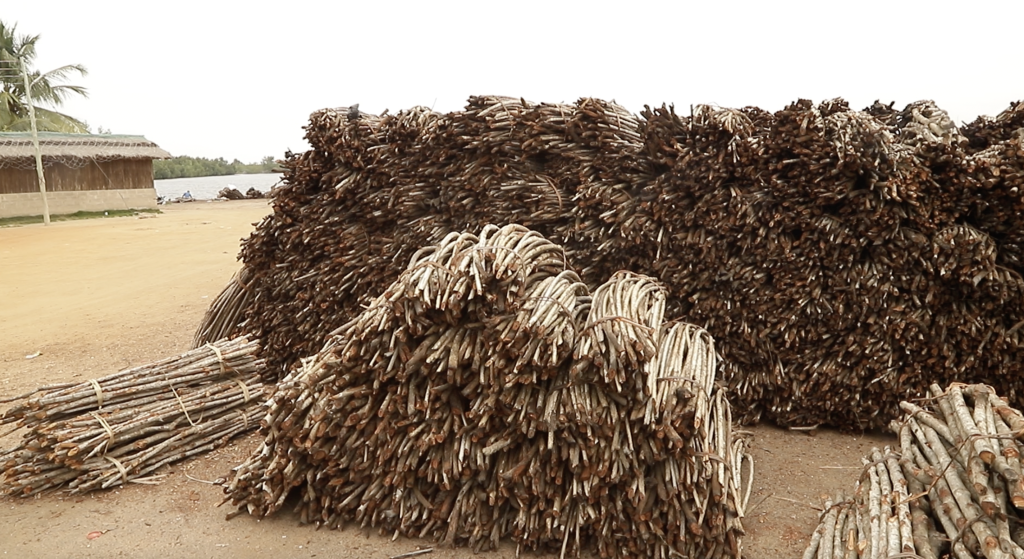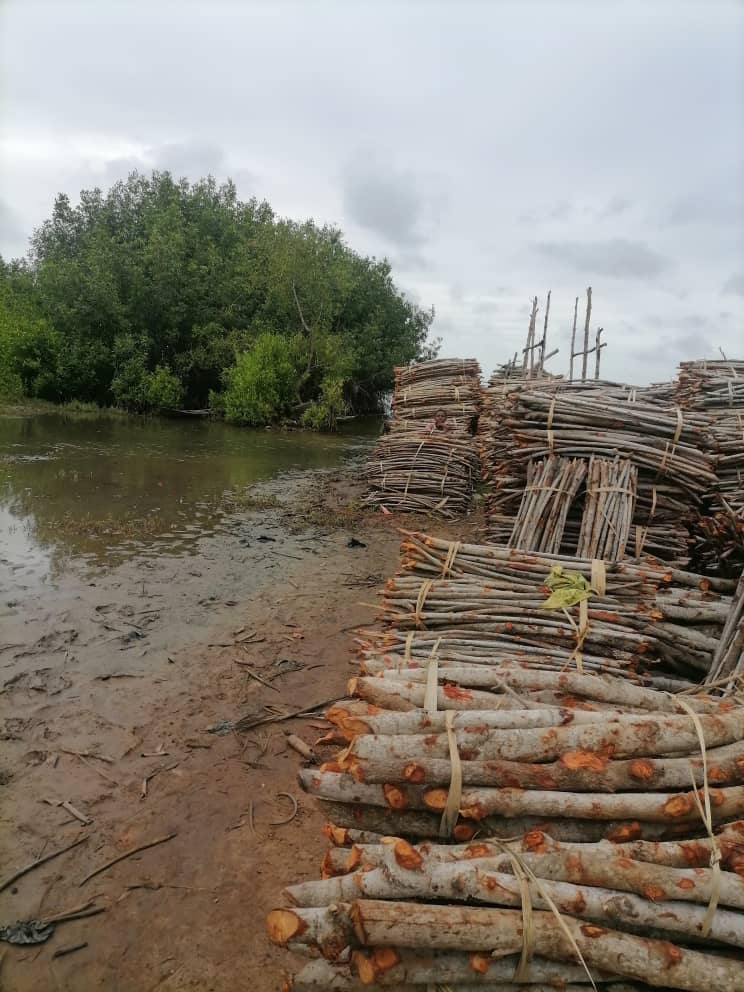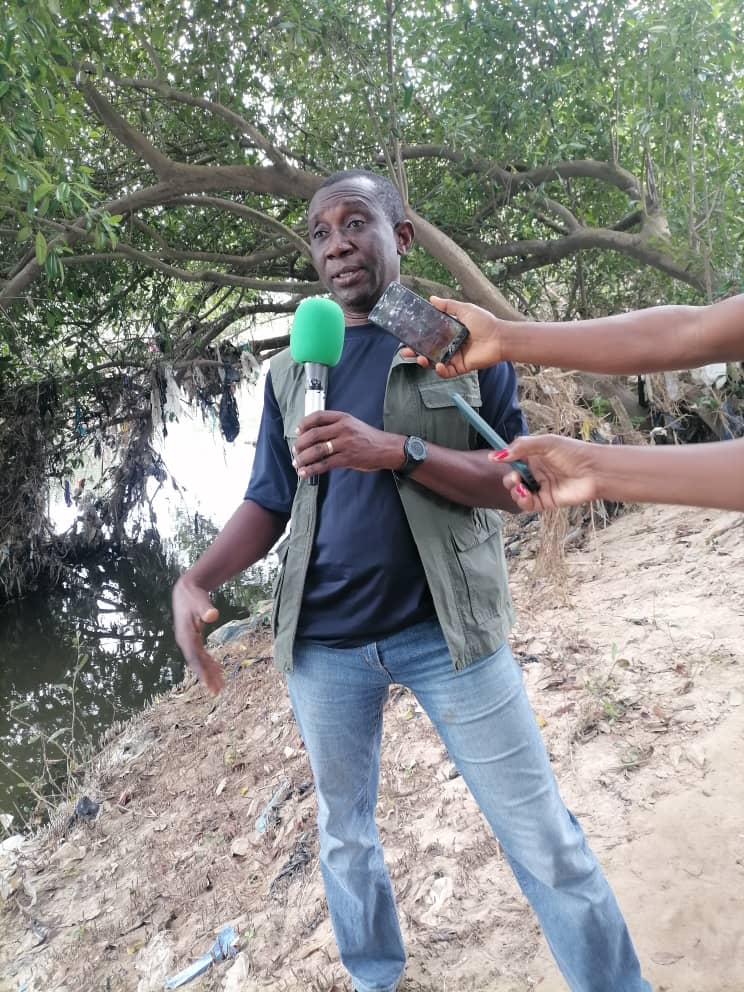A GNA feature by Lydia Kukua Asamoah
Wetlands and Ramsar sites
Accra, Aug. 25, GNA – Most wetlands and Ramsar sites in Ghana hosting mangroves that play a key role in mitigating the impact of climate change and coastal flooding are under serious threat.
This is due to the long neglect of conservation laws and overexploitation, as well as other human activities that interfere with the natural ecology.
A tour to some of the wetlands and mangrove sites in the Volta and Greater Accra regions revealed that the shrub trees, noted for collecting the highest emission of carbons even more than forests, are being “weeded away” while some of the sites are being filled up for human habitation.

People also cut the mangroves for firewood and other uses.
Importance
Ecologists have explained that: “Mangroves help regulate climate and that the carbon storage potential of mangroves is three to five times higher than that of tropical upland forest due to strong carbon storage in the soil.”
This explains why mangroves that grow effectively within wetlands help in the fight against climate change by storing a higher amount of carbon than rainforests can.
Ghana currently has five coastal wetlands designated as Ramsar sites with one inland wetland. In all, the wetlands constitute about 10 per cent of the country’s total land area of 23.9 million hectares.
They are the Anglo-Keta Lagoon Complex in the Volta region, the Densu Delta, Sakumo Lagoon and the Songor Lagoon in the Greater Accra region, and the Muni Lagoon, in the Central and the Owabi lagoon in the Ashanti regions respectively.
Ramsar sites are wetland sites designated to be of international importance and are protected under strict guidelines of the Ramsar Convention on Wetlands, which Ghana ratified in 1975.
Experts have argued that protecting and conserving mangroves are crucial for the climate resilience of the world’s coastlines as they are threatened by rising sea levels, frequent and powerful storms and saltwater intrusion into drinking water.

Also, available data indicates that mangrove resources serve as a source of livelihood for 20 million people living near mangroves worldwide.
For communities that live near mangrove shrubs, they are permitted by law to sustainably access them for wood fuel for cooking, for smoking fish, and as a source of wood for building houses as well as for ecotourism reasons to generate some income.
Mangrove also plays a critical role as breeding grounds for fish and boost the purification of underground water.
Tour of the sites
However, during the tour organised by the International Union for Conservation of Nature (IUCN) in collaboration with the Media Platform on Environment and Climate Change (MPEC) to commemorate activities marking this year’s International Mangrove Day in Ghana, the team saw many of the mangrove sites being taking over by residents while the other wetlands were highly polluted.
At the Densu Delta Ramsar site, being managed by the Wildlife Division of the Forestry Commission and the Panbros Salt Industries Limited, which had the salt factory sited within its buffer, it was noticed that encroachment within the core of the Ramsar was minimal with the mangrove being intact with less degradation.
Mr Dickson Agyeman, Wetlands Operation Manager, Wildlife Division, Forestry Commission, explained to the media that but for the partnership with the private sector, being Panbros Limited, in managing the site, encroachment could have been a big issue.
Again, frequent flooding of the entire area also prevents community members from taking over the happening elsewhere.
At the Korle lagoon, it was noticed that the bird and mangrove were in a bad state, with the ecosystem being stressed out, and the water body not conducive for any development of biodiversity, pointing a sharp contrast from the situation at the Densu Delta.

At Kpeshie Lagoon, (not a Ramsar site) the media team saw the conversion of a wetland into other uses, which continues to affect the ecosystem with the mangroves gradually losing their habitat, and water pollution all over. People had also filled the water to take over the habitation.
There were few birds seen around with biodiversity basically absent.
At Ada Obane, the Songhor Lagoon, which is also designated as a biosphere reserve that accommodates the utilisation of resources within its core zone, it was noticed that vegetation was growing beautifully, while the people were readily supporting effort of regenerating and restoration of the mangroves as they cut some for usage under the biosphere reserve concept.
Mr Agyeman explained that the “biosphere reserve concept thinks that if people use the resources within the core zone it is likely to be depleted within a time frame, so there is the need to allow the resources to regenerate within the core and shift to the buffer to allow people to utilised.
“We tried it and for now it has been successful, and the spill over is even though not the best, but we are gradually getting closer to that area.”
Still at Ada-Obane, the degraded area near the Songhor was seen to be restored by the people under a project championed by the Wildlife Division. But that project was hampered by the inflow of brackish water due to the blockade of the creeks.

Mr Victor Amenewor Apeku, an Elder at Ada-Obane on behalf of the people, pleaded that the creeks be dredged regularly to allow the inflow of the water to flood more of the area to enable them to plant more mangroves for use and for the protection of the ecosystem.
Mr Agyeman, however, explained that excavators were needed to dredge the creeks and remove the silting materials, which would need the collaboration of the District Assembly and other non-governmental organisations that were interested in mangrove restoration to do so.
At the Keta Lagoon complex Ramsar sites, where the Wildlife Division was leading efforts at restoration, education and law enforcement on the mangroves, the team noticed mangrove farming underway, where the mangroves were planted with the intent of cutting and selling and replanting.
“The people here were encouraged by the Wildlife Division to do sustainable farming to preserve the ecosystem.”
Mr Agyeman said: “We thought that there were other by-products of mangroves apart from the cutting and selling as firewood, ecotourism and ecosystem services also exist.
Some of the communities have already accepted to go into restoration activities in the area, where the Wildlife has also gone into alternative woodlots also planting for the people to depend solely on the mangroves.
Other interventions and measures being undertaken by Wildlife and its partner conservation organisations included programmes like “ecosystem manipulations, ecological restoration, conservation education, livelihood options and climate-smart interventions like the promotion of efficient wood use or charcoal stoves.
Mr Agyemang explained that currently, there are no laws or policies in Ghana specifically governing mangrove ecosystem management as the Government had also not outrightly acquired the mangrove areas.
Therefore, owners of the sites including chiefs and other community members undertake activities which unfortunately degrade the mangrove habitats.
It is, therefore, welcoming, that Ghana is a beneficiary of the IUCNs and the European Union project that sought to link governance and the production systems with the structure of conservation of mangroves at the territorial levels.
That project falls under a nine million Euro project in four conservation parity areas within nine African countries namely Ghana, Benin, Togo, Sierra Leone, and the Gambia.
Benefits
Mr Anthony Adeea Mba, Technical Assistant, IUCN Mangroves Project in Ghana, explained the country started to benefit from the small grants in 2019 to among other activities, support demonstrative mangrove planting, mangrove restoration and the cultivation of woodlots for residents to use sustainably, alongside other advocacy activities in partnership with some NGO’s and academia.

Recommendations
Considering the importance of mangroves in countries, it is important for Ghana to design a detailed policy and proper documentation regarding the governance of the wetlands while agencies like the Water Resources Commission and Wildlife Division and community members also make efforts to guard and restore the delicate shrubs that have become useful for conservation.
A clear national policy is needed to give direction and guidelines to manage wetlands and Ramsar sites in the country, Mr Agyeman has pleaded.
GNA